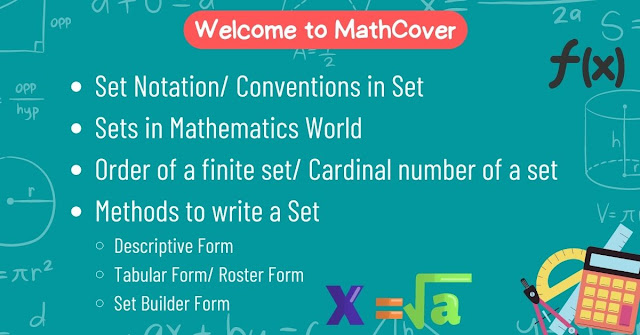Set Notation/ Conventions in Set
- English capital letters are typically used to represent sets.
- Small letters from the English alphabet are used to represent the elements of a set.
i.e, $a,$ $b,$ $c,...$ $x,$ $y,$ $z$
- Its elements are written within curly brackets $\{$ $\}$ and each element is separated by commas $($ $,$ $)$.
- The phrases objects, elements, and members of a set are similar.
- If $a$ is an element of a set, we say that "$a$ belongs to set $A$" or "$a$ is a member of set $A$". The Greek symbol $ε$ (epsilon) is used to indicate the phrase "belongs to" Thus, we write $a\epsilon A$
- If "$b$" is not an element of the set "$A$", we write $b∉A$ and read as "$b$ is not an element of the set $A$".
Sets in Mathematics World
$N$: The set of all natural numbers.
$W$: The set of all whole numbers.
$Z$: The set of all integers.
$Q$: The set of all rational numbers.
OR
$Q$ $=\{x|x$ $=\frac{p}{q}$ $:p,q$ $\varepsilon Z$ $,q\neq 0\}$
$Q'$: The set of all irrational numbers.
OR
$Q'$ $=\{x|x$ $\neq \frac{p}{q}$ $:p,q\varepsilon Z,$ $q\neq 0\}$
$R$: The set of all real numbers.
$R$ $=Q∪Q'$
- The number of all elements in a finite set $"A"$ is called the order of this set.
- It is denoted by $O(A)$ or $n(A)$.
- It is also called a cardinal number of the set.
- It is also called a cardinal number of the set.
Example:
$A$ $=\{a,$ $b,$ $c,$ $d\}$ $⇒$ $n(A)$ $=4$
$B$ $=\{2,$ $4,$ $6,$ $8,$ $10,$ $12,$ $14\}$ $⇒$ $n(B)$ $=7$
$C$ $=\{1,$ $2,$ $3,...$ $98,$ $99,$ $100\}$ $⇒$ $n(C)$ $=100$
Methods to write a Set
There are three methods to write a set
1) Descriptive Form2) Tabular Form/ Roster Form
3) Set Builder Form
Descriptive Form
- Descriptive form refers to a collection that may be described with the aid of a statement.
Example:
$A=$ The collection of all real numbers under $10.
$B=$ The English alphabet's first five letters set.
$C=$ The set of positive integers.
Tabular Form/ Roster Form
- In roster form, all the elements of a set are listed and denoted by curly braces $\{$ $\}$. and commas $($ $,$ $)$ to separate the two.
Example:
Points to be noted in the roster form
- The arrangement of the elements on a roster is not necessary.
You can write all of the vowels in the English alphabet as
$\{a,$ $e,$ $i,$ $o,$ $u\}$ or $\{a,$ $i,$ $e,$ $o,$ $u\}$ or $\{e,$ $i,$ $a,$ $u,$ $o\}$ or $\{u,$ $a,$ $e,$ $i,$ $o\}$
- A set is indefinitely long if there are three dots at the end of it.
Example:
- An element is not repeated in the roster format.
Example:
The set of letters that make up the word "school" is
$\{s,$ $c,$ $h,$ $o,$ $l\}$
Set Builder Form
- This form asks us to list a property or rule that provides us with all of the set's components.
- $A$ $=\{x: P(x)\}$ where $P(x)$ is the property by which $xεA$ and colon $":"$ stands for "such that".
Example:
$A$ $=\{1,$ $2,$ $3,$ $4,$ $5\}$
$\{x:x\le 5,$ $x\epsilon N\}$ $→$ Set Builder
$B$ $=\{0,$ $1,$ $8,$ $27,$ $64\}$
$B=\{x^3$ $:$ $x<5,$ $xεW\}$
$C$ $=\{2,$ $4,$ $6,$ $8,$ $10\}$
$C$ $=\{x:x\le 10$ $\wedge x\epsilon E\}$


.jpg)
0 Comments